If you are not going into the museum to see art, Julien De Casabianca is happy to bring it out to the street for you. Additionally, if the museum has been closed by an earthquake, he’ll make sure the art gets a public viewing nonetheless.
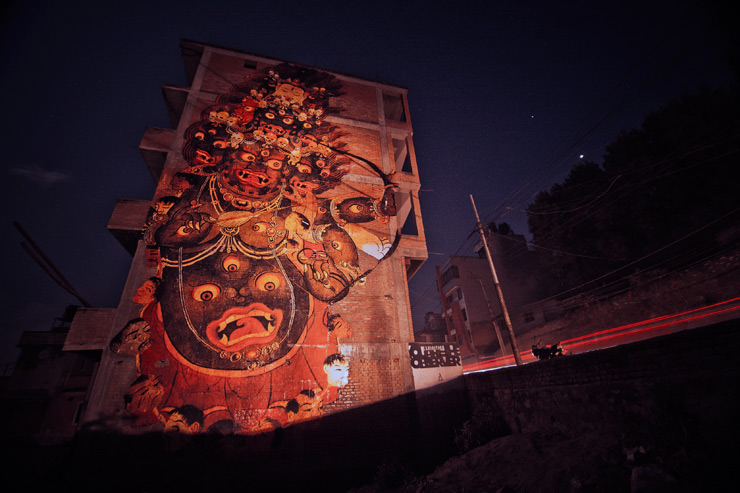
Julien De Casabianca. Outings Project. Kathmandu, Nepal. January, 2017 (photo © Karma Tshering Gurung & Sanam Tamang/ Artudio)
In Kathmandu recently Street Artist Julien de Casabianca continued his Outings Project by bringing a centuries-old painting outside to the side of the Artudio building in Swoyambhu on Chhauni Hospital Road with the help of Matt Rockwell of the humanitarian hackers group called DisasterHack.
He tells us that the obstacles to getting this piece up seemed insurmountable at times due to the broken social and infrastructural systems in Nepal that still plague people even today, nearly two years since the catastrophic earthquake that killed nearly 9,000 and injured 22,000 more.
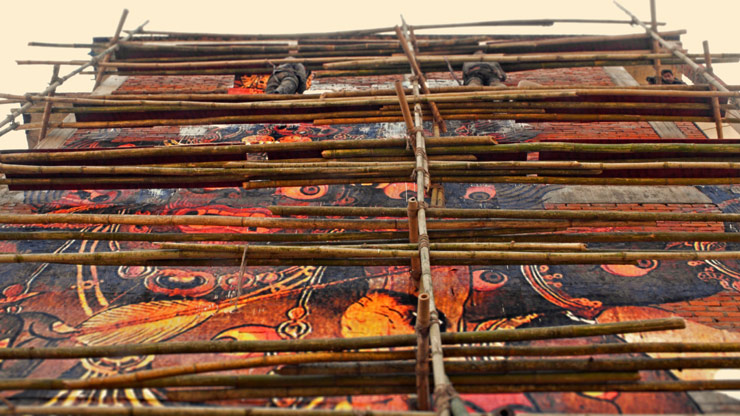
Julien De Casabianca. Outings Project. Kathmandu, Nepal. January, 2017 (photo © Matthew Rockwell/DisasterHack)
The image itself is of a scary/reassuring Mahākāla – is a deity common to Hinduism, Buddhism and Sikhism which contains layers of meaning and is full of symbolism referring to the mystical, spiritual, and allegorical matters.
Among the challenges of wheat-pasting the fiery god piece was an ongoing sense of light vertigo from climbing, walking, and balancing on a bamboo constructed scaffolding, not to mention the difficulty of securing art materials.
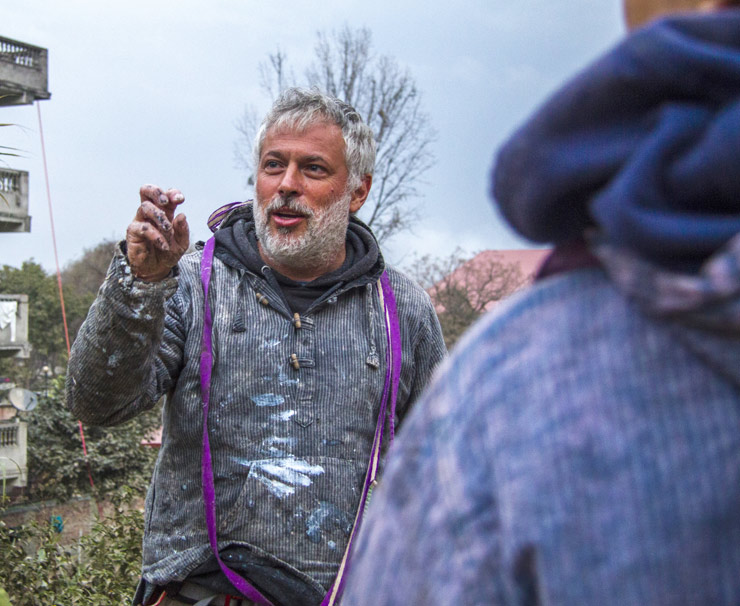
Julien De Casabianca. Outings Project. Kathmandu, Nepal. January, 2017 (photo © Karma Tshering Gurung & Sanam Tamang/ Artudio)
With a goal of re-imagining how technology and art can be utilized to create social transformation and economic independence in challenging communities, the organizers of DisasterHack say they are building a flexible network of humanitarians who can use their technical skills to hack human solutions in developing societies.
With that in mind, you know that while this new wheat-pasted art may be just a piece of art to some, to others it is a reverent reminder of a cultures history and a sign of hope for the future.
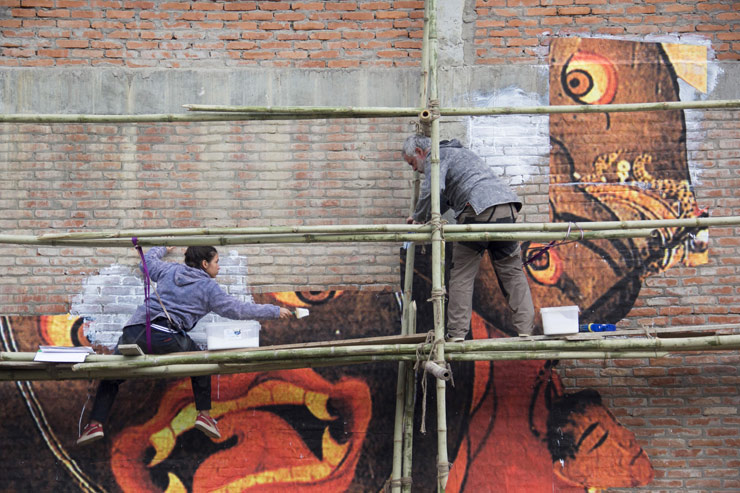
Julien De Casabianca. Outings Project. Kathmandu, Nepal. January, 2017 (photo © Karma Tshering Gurung & Sanam Tamang/ Artudio)
We spoke with Julien about his experience bringing this localized historical art work to the community who they may never see it otherwise.
Brooklyn Street Art: How was your experience in Kathmandu?
Julien de Casabianca: It was great meetings with Matt from DisasterHack and making an incredible project in a crazy country where everything is so difficult, long, painful; and where almost everyone has been in some kind of deep personal pain since the earthquake happened. We pasted it on a Artudio building where they have children’s art workshops and from up on the scaffolding we could see all of Kathmandu, a hurting city.
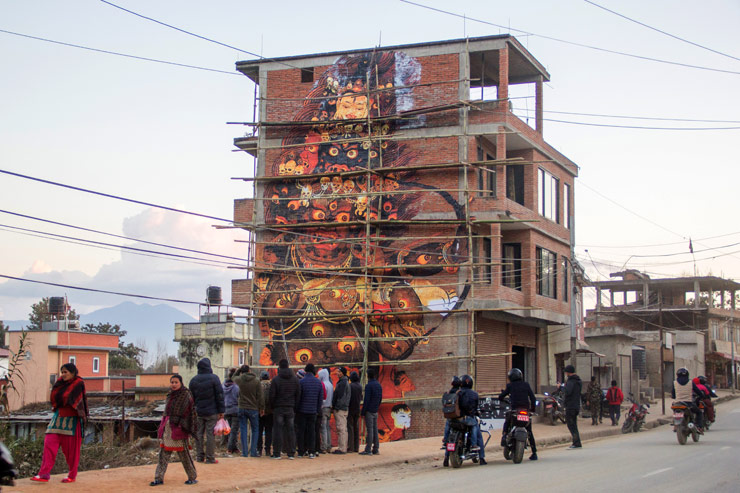
Julien De Casabianca. Outings Project. Kathmandu, Nepal. January, 2017 (photo © Karma Tshering Gurung & Sanam Tamang/ Artudio)
BSA: How was the experience on the bamboo scaffolding? Bamboo is about the strongest material there is but still it requires a bit of trust in the people who build the scaffolding no?
JC: It’s scary yes, just totally flexible under your feet! Even though we added some security fence and safety harnesses, you still feel in like your equilibrium is being questioned all the time.
BSA: What were you doing in Katmandu besides putting up this enormous piece?
JC: I was in Katmandu just to paste this monumental piece. I had pasted in India a few weeks before and I wanted to give a gift to DisasterHack because of the good work they do – they have many art and technology programs for kids. They even are working on designing and building prosthetic limbs for disabled children using 3D printers. They’ve done an incredible job in Nepal since the terrible earthquake.
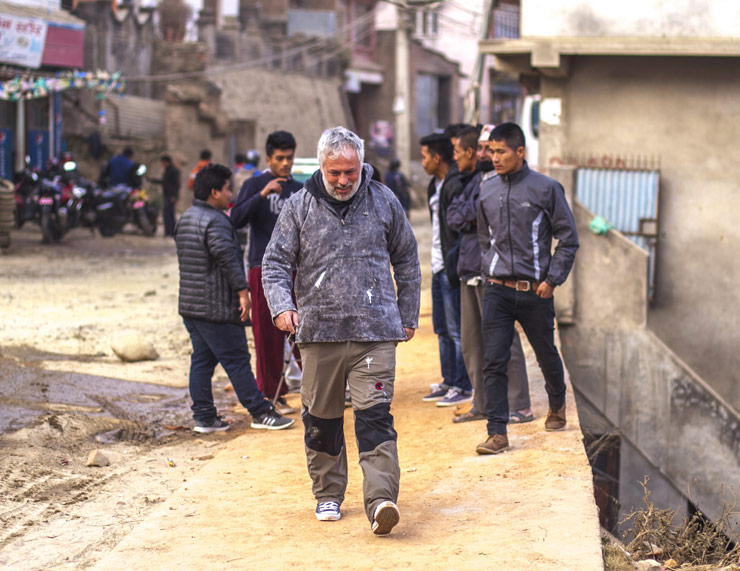
Julien De Casabianca. Outings Project. Kathmandu, Nepal. January, 2017 (photo © Karma Tshering Gurung & Sanam Tamang/ Artudio)
BSA: What is the meaning of the piece? Is it based on a classic painting that was housed in a museum in Nepal?
JC: As always, I use traditional local paintings that are found in museums. In Kathmandu the museum was closed because of the earthquake, so I found it on the web. The
Mahākāla is a sort of god, a guardian, protector, even though he has a scary body and face. I don’t know a lot about it; I asked some priests from the temples and monasteries all around if it was ok to paste this giant Mahākāla in front of Swayambunath temple, which build at the start of 5th century. They were so enthusiastic, happy and grateful. They told us that the Mahākāla has
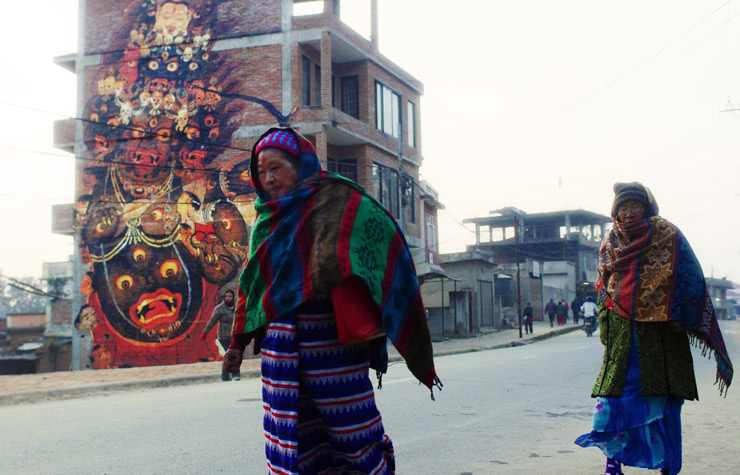
Julien De Casabianca. Outings Project. Kathmandu, Nepal. January, 2017 (photo © Karma Tshering Gurung & Sanam Tamang/ Artudio)
The 3 eyes symbolize his understanding of past, present and future. They said that his crown of skulls represent the five poisoned disappointments; anger, desire, ignorance, jealousy, and pride – but all are transformed by wisdom.
BSA: Do you know who originally painted it and when?
JC: We don’t know, nobody does. But most likely it was painted sometime between 7 and 15 centuries ago!
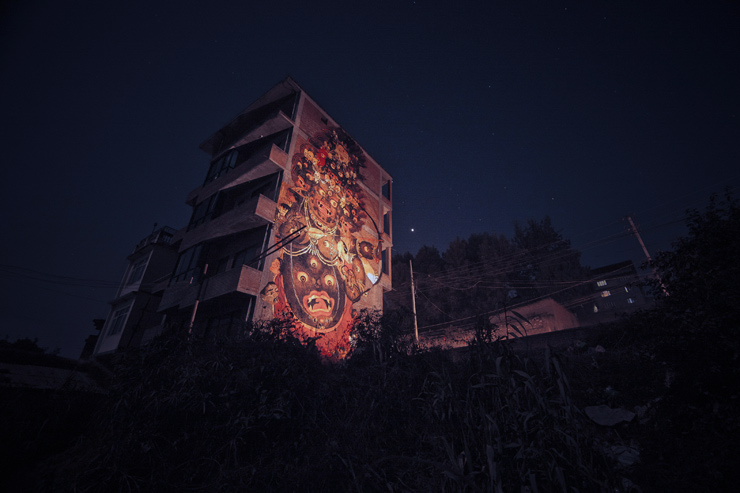
Julien De Casabianca. Outings Project. Kathmandu, Nepal. January, 2017 (photo © Karma Tshering Gurung & Sanam Tamang/ Artudio)
Other Articles You May Like from BSA:
The Earth says “Thanks!” to us today. Unfortunately it doesn’t realize that all this clean air and water from the last couple of months is not intentional – we just had to stay inside our homes a...
"Wir sind das Volk!" and Dildos from the "Confusionist" Continuing his human sticker campaign, street artist Rallitox has gathered a nice crowd in front of this portion of the Berlin Wall, otherwise ...
New York street artist Jilly Ballistic has been borrowing black and white photos from an earlier era of economic depression to paste on the streets for half a dozen years or so. The effect is nostalgi...
The bright light of truth reveals things you may not have seen previously and Fabio Petani, the 30 year old Turin-based muralist is talking about it in Ukraine. The mural combines two elements often s...
An unusual exhibition that combines works from the established to the newcomer, Monumenta was mounted by a team of about 25 people in only five weeks inside this cavernous former metalworks ...
 BROOKLYN STREET ART LOVES YOU MORE EVERY DAY
BROOKLYN STREET ART LOVES YOU MORE EVERY DAY










